Organizational Change Management Report: Le Chic Restaurant's Strategy
VerifiedAdded on 2022/10/11
|12
|2516
|44
Report
AI Summary
This report provides a comprehensive analysis of change management strategies for Le Chic restaurant, focusing on improving services and customer experience. It examines internal and external drivers of change using SWOT and PEST analyses, exploring the nature of change within the organization and employee reactions to these changes. The report uses Kotter's theory to understand the nature of change, and addresses employee resistance, fear of the unknown, and changes to routine. The report recommends the ADKAR model for successful change implementation, including training, communication, and reinforcement, to overcome barriers and achieve organizational goals such as increased profit margins and improved brand image. The report concludes with a summary of findings and recommendations for effective change management within the restaurant.
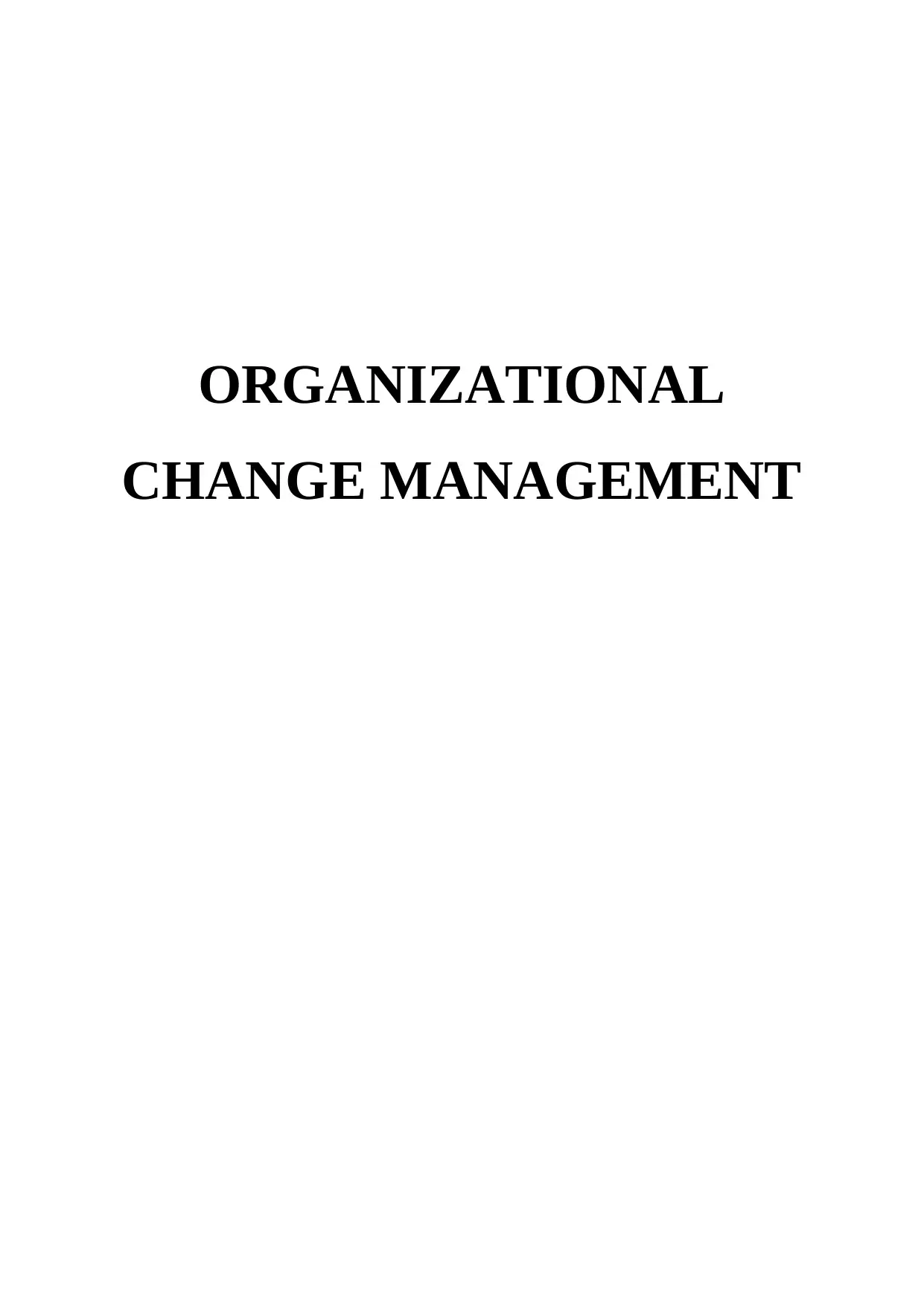
ORGANIZATIONAL
CHANGE MANAGEMENT
CHANGE MANAGEMENT
Paraphrase This Document
Need a fresh take? Get an instant paraphrase of this document with our AI Paraphraser
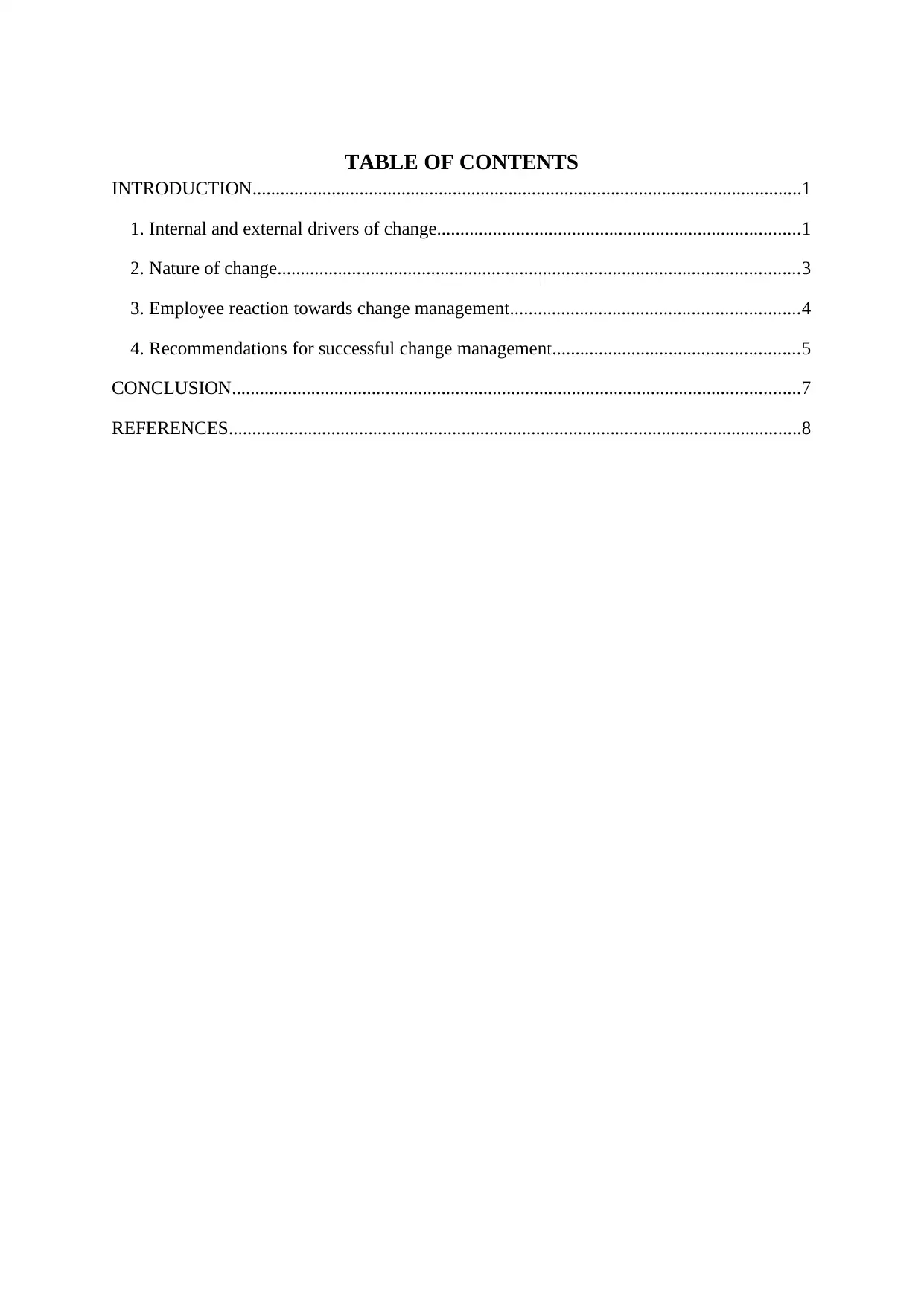
TABLE OF CONTENTS
INTRODUCTION......................................................................................................................1
1. Internal and external drivers of change..............................................................................1
2. Nature of change................................................................................................................3
3. Employee reaction towards change management..............................................................4
4. Recommendations for successful change management.....................................................5
CONCLUSION..........................................................................................................................7
REFERENCES...........................................................................................................................8
INTRODUCTION......................................................................................................................1
1. Internal and external drivers of change..............................................................................1
2. Nature of change................................................................................................................3
3. Employee reaction towards change management..............................................................4
4. Recommendations for successful change management.....................................................5
CONCLUSION..........................................................................................................................7
REFERENCES...........................................................................................................................8

List of figures
Figure 1: Kotter's theory.............................................................................................................3
Figure 2: ADKAR model of change..........................................................................................6
Figure 1: Kotter's theory.............................................................................................................3
Figure 2: ADKAR model of change..........................................................................................6
⊘ This is a preview!⊘
Do you want full access?
Subscribe today to unlock all pages.

Trusted by 1+ million students worldwide

List of tables
Table 1: SWOT analysis............................................................................................................1
Table 2: PEST analysis..............................................................................................................2
Table 1: SWOT analysis............................................................................................................1
Table 2: PEST analysis..............................................................................................................2
Paraphrase This Document
Need a fresh take? Get an instant paraphrase of this document with our AI Paraphraser
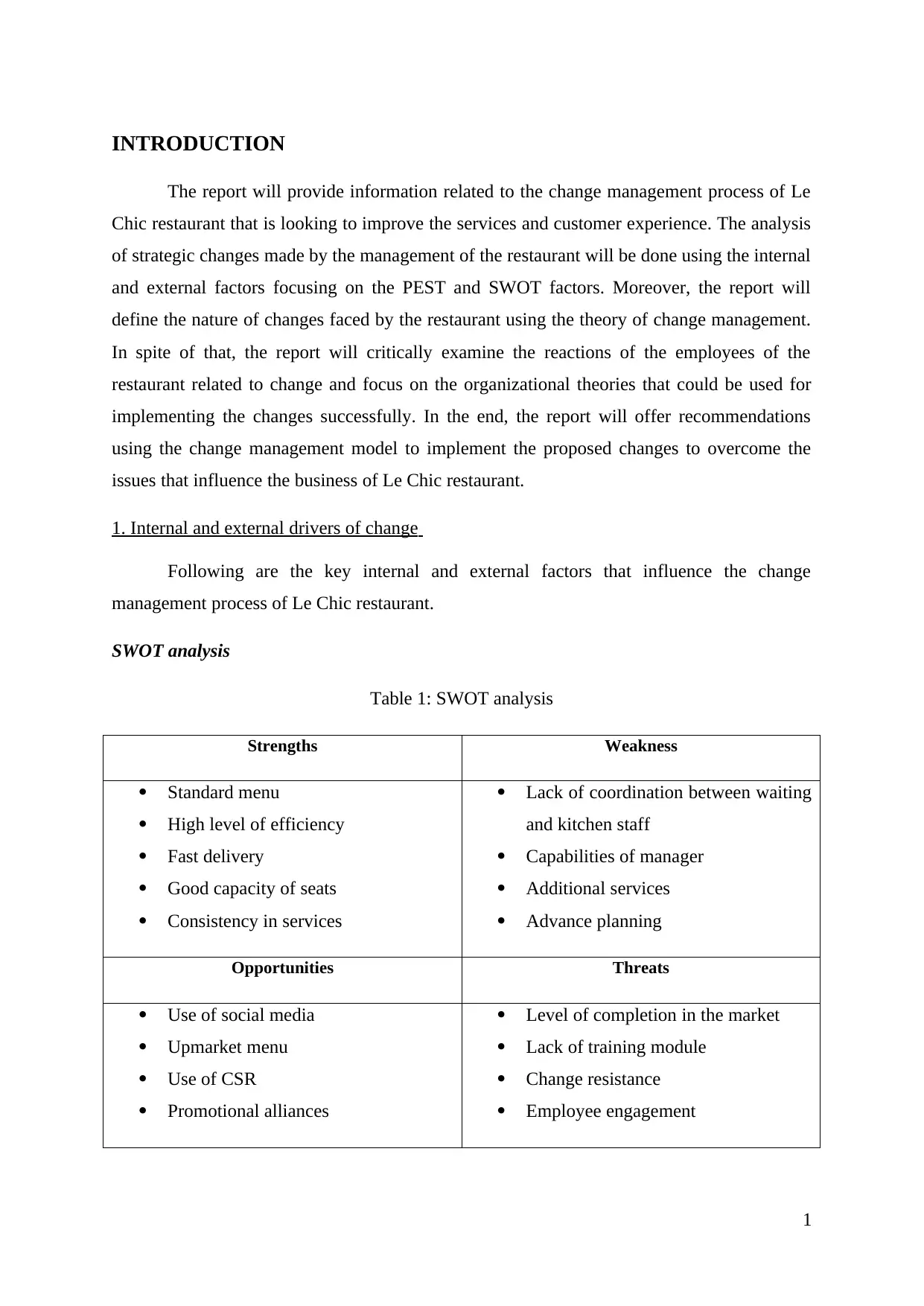
INTRODUCTION
The report will provide information related to the change management process of Le
Chic restaurant that is looking to improve the services and customer experience. The analysis
of strategic changes made by the management of the restaurant will be done using the internal
and external factors focusing on the PEST and SWOT factors. Moreover, the report will
define the nature of changes faced by the restaurant using the theory of change management.
In spite of that, the report will critically examine the reactions of the employees of the
restaurant related to change and focus on the organizational theories that could be used for
implementing the changes successfully. In the end, the report will offer recommendations
using the change management model to implement the proposed changes to overcome the
issues that influence the business of Le Chic restaurant.
1. Internal and external drivers of change
Following are the key internal and external factors that influence the change
management process of Le Chic restaurant.
SWOT analysis
Table 1: SWOT analysis
Strengths Weakness
Standard menu
High level of efficiency
Fast delivery
Good capacity of seats
Consistency in services
Lack of coordination between waiting
and kitchen staff
Capabilities of manager
Additional services
Advance planning
Opportunities Threats
Use of social media
Upmarket menu
Use of CSR
Promotional alliances
Level of completion in the market
Lack of training module
Change resistance
Employee engagement
1
The report will provide information related to the change management process of Le
Chic restaurant that is looking to improve the services and customer experience. The analysis
of strategic changes made by the management of the restaurant will be done using the internal
and external factors focusing on the PEST and SWOT factors. Moreover, the report will
define the nature of changes faced by the restaurant using the theory of change management.
In spite of that, the report will critically examine the reactions of the employees of the
restaurant related to change and focus on the organizational theories that could be used for
implementing the changes successfully. In the end, the report will offer recommendations
using the change management model to implement the proposed changes to overcome the
issues that influence the business of Le Chic restaurant.
1. Internal and external drivers of change
Following are the key internal and external factors that influence the change
management process of Le Chic restaurant.
SWOT analysis
Table 1: SWOT analysis
Strengths Weakness
Standard menu
High level of efficiency
Fast delivery
Good capacity of seats
Consistency in services
Lack of coordination between waiting
and kitchen staff
Capabilities of manager
Additional services
Advance planning
Opportunities Threats
Use of social media
Upmarket menu
Use of CSR
Promotional alliances
Level of completion in the market
Lack of training module
Change resistance
Employee engagement
1
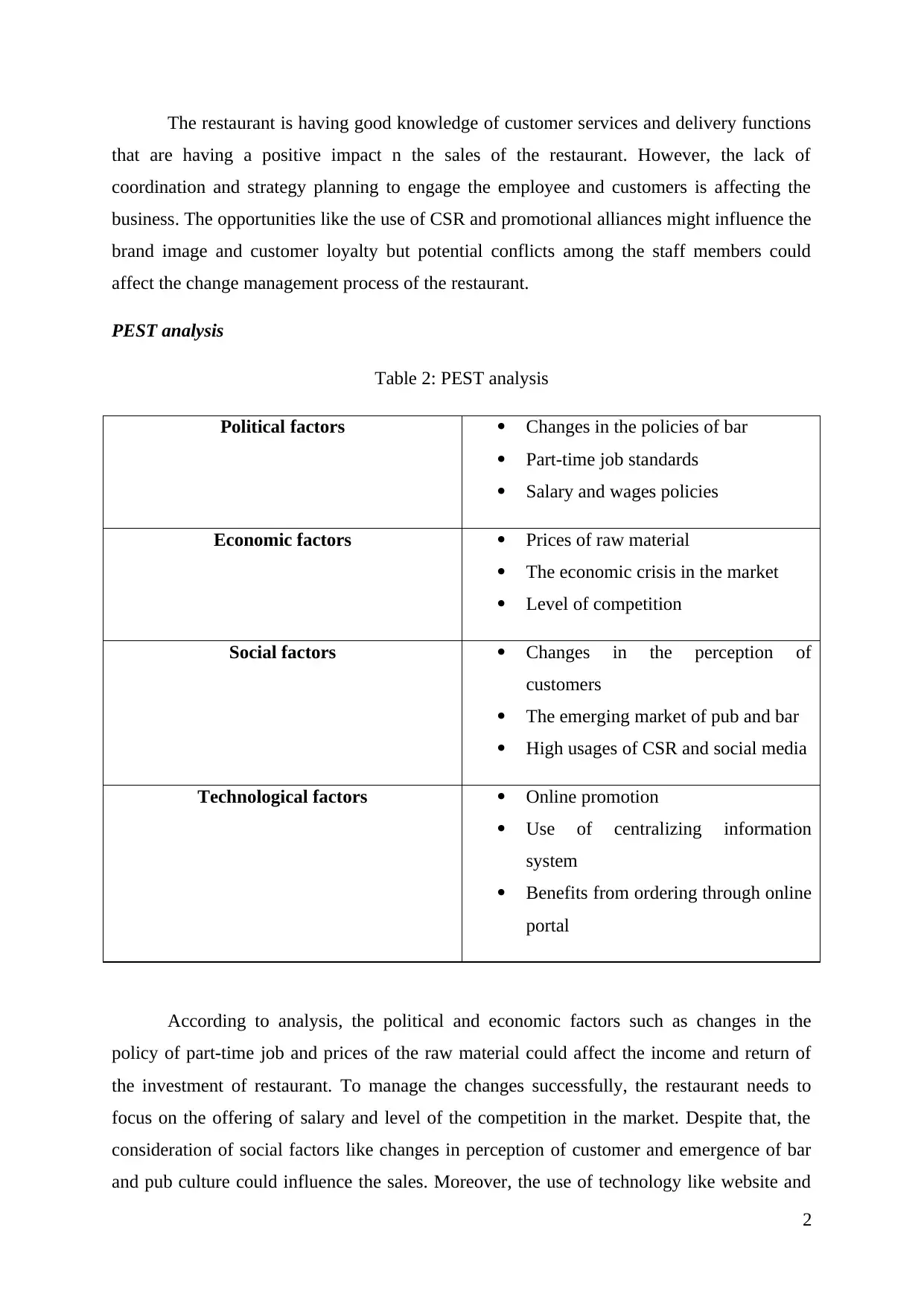
The restaurant is having good knowledge of customer services and delivery functions
that are having a positive impact n the sales of the restaurant. However, the lack of
coordination and strategy planning to engage the employee and customers is affecting the
business. The opportunities like the use of CSR and promotional alliances might influence the
brand image and customer loyalty but potential conflicts among the staff members could
affect the change management process of the restaurant.
PEST analysis
Table 2: PEST analysis
Political factors Changes in the policies of bar
Part-time job standards
Salary and wages policies
Economic factors Prices of raw material
The economic crisis in the market
Level of competition
Social factors Changes in the perception of
customers
The emerging market of pub and bar
High usages of CSR and social media
Technological factors Online promotion
Use of centralizing information
system
Benefits from ordering through online
portal
According to analysis, the political and economic factors such as changes in the
policy of part-time job and prices of the raw material could affect the income and return of
the investment of restaurant. To manage the changes successfully, the restaurant needs to
focus on the offering of salary and level of the competition in the market. Despite that, the
consideration of social factors like changes in perception of customer and emergence of bar
and pub culture could influence the sales. Moreover, the use of technology like website and
2
that are having a positive impact n the sales of the restaurant. However, the lack of
coordination and strategy planning to engage the employee and customers is affecting the
business. The opportunities like the use of CSR and promotional alliances might influence the
brand image and customer loyalty but potential conflicts among the staff members could
affect the change management process of the restaurant.
PEST analysis
Table 2: PEST analysis
Political factors Changes in the policies of bar
Part-time job standards
Salary and wages policies
Economic factors Prices of raw material
The economic crisis in the market
Level of competition
Social factors Changes in the perception of
customers
The emerging market of pub and bar
High usages of CSR and social media
Technological factors Online promotion
Use of centralizing information
system
Benefits from ordering through online
portal
According to analysis, the political and economic factors such as changes in the
policy of part-time job and prices of the raw material could affect the income and return of
the investment of restaurant. To manage the changes successfully, the restaurant needs to
focus on the offering of salary and level of the competition in the market. Despite that, the
consideration of social factors like changes in perception of customer and emergence of bar
and pub culture could influence the sales. Moreover, the use of technology like website and
2
⊘ This is a preview!⊘
Do you want full access?
Subscribe today to unlock all pages.

Trusted by 1+ million students worldwide
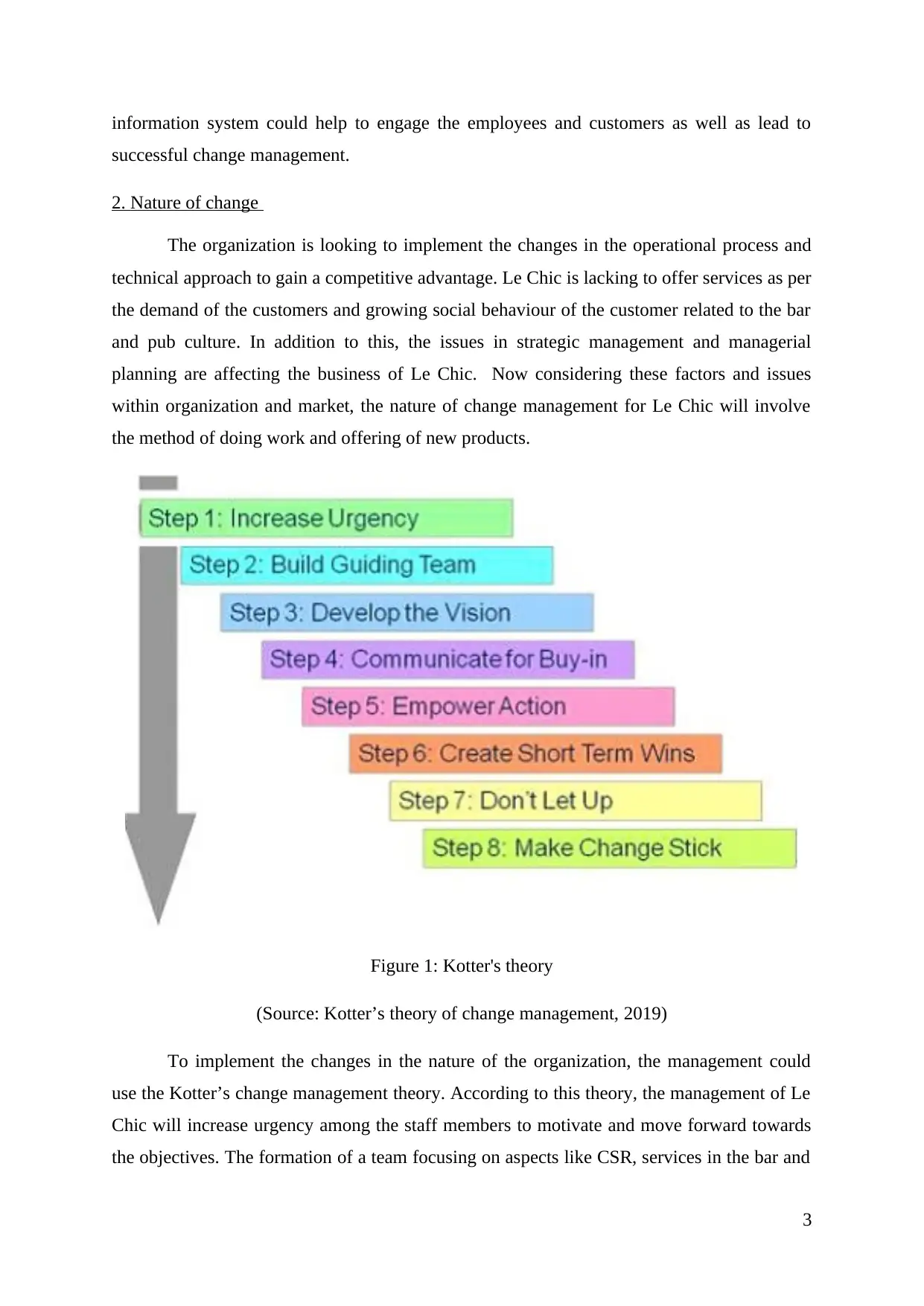
information system could help to engage the employees and customers as well as lead to
successful change management.
2. Nature of change
The organization is looking to implement the changes in the operational process and
technical approach to gain a competitive advantage. Le Chic is lacking to offer services as per
the demand of the customers and growing social behaviour of the customer related to the bar
and pub culture. In addition to this, the issues in strategic management and managerial
planning are affecting the business of Le Chic. Now considering these factors and issues
within organization and market, the nature of change management for Le Chic will involve
the method of doing work and offering of new products.
Figure 1: Kotter's theory
(Source: Kotter’s theory of change management, 2019)
To implement the changes in the nature of the organization, the management could
use the Kotter’s change management theory. According to this theory, the management of Le
Chic will increase urgency among the staff members to motivate and move forward towards
the objectives. The formation of a team focusing on aspects like CSR, services in the bar and
3
successful change management.
2. Nature of change
The organization is looking to implement the changes in the operational process and
technical approach to gain a competitive advantage. Le Chic is lacking to offer services as per
the demand of the customers and growing social behaviour of the customer related to the bar
and pub culture. In addition to this, the issues in strategic management and managerial
planning are affecting the business of Le Chic. Now considering these factors and issues
within organization and market, the nature of change management for Le Chic will involve
the method of doing work and offering of new products.
Figure 1: Kotter's theory
(Source: Kotter’s theory of change management, 2019)
To implement the changes in the nature of the organization, the management could
use the Kotter’s change management theory. According to this theory, the management of Le
Chic will increase urgency among the staff members to motivate and move forward towards
the objectives. The formation of a team focusing on aspects like CSR, services in the bar and
3
Paraphrase This Document
Need a fresh take? Get an instant paraphrase of this document with our AI Paraphraser
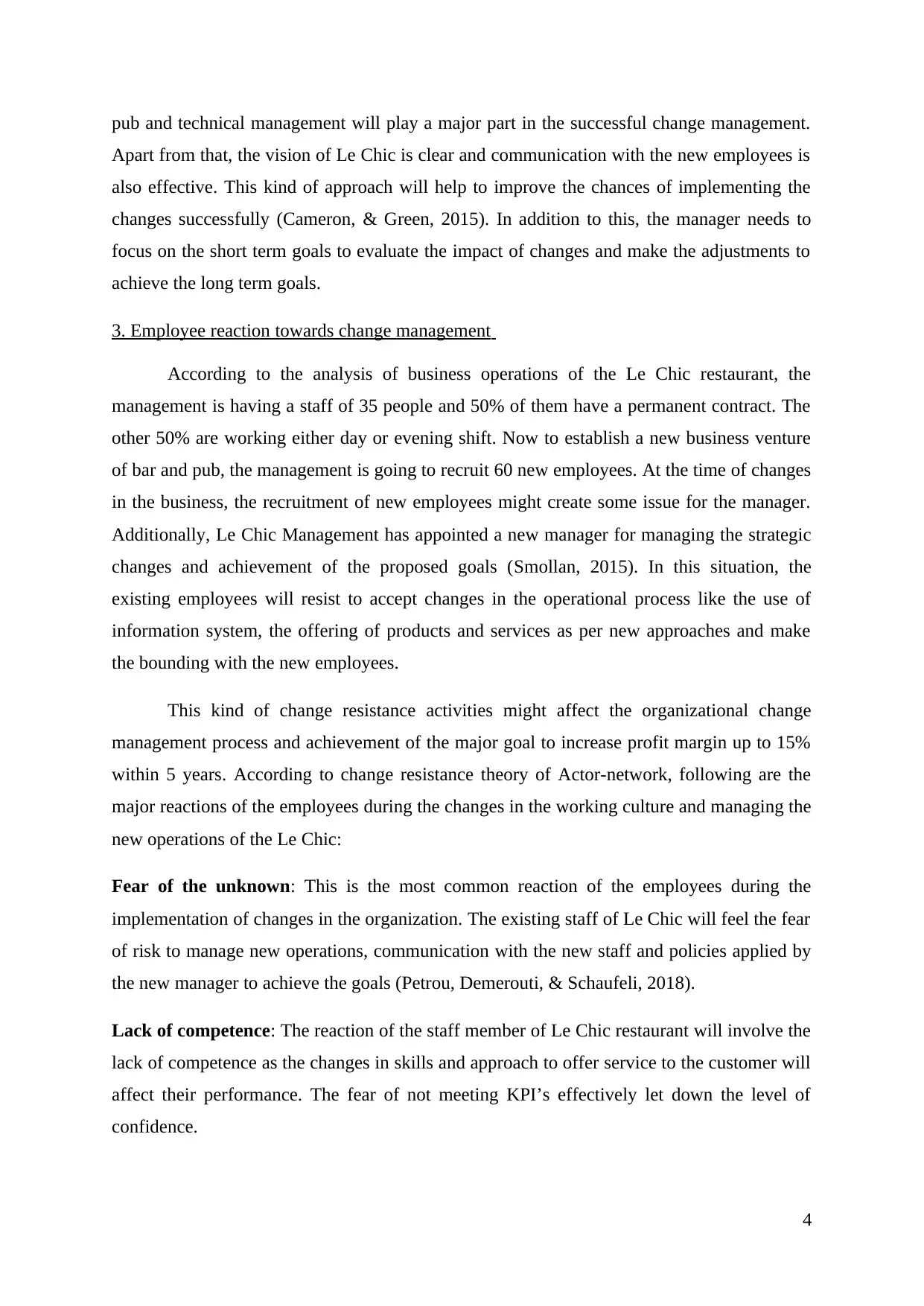
pub and technical management will play a major part in the successful change management.
Apart from that, the vision of Le Chic is clear and communication with the new employees is
also effective. This kind of approach will help to improve the chances of implementing the
changes successfully (Cameron, & Green, 2015). In addition to this, the manager needs to
focus on the short term goals to evaluate the impact of changes and make the adjustments to
achieve the long term goals.
3. Employee reaction towards change management
According to the analysis of business operations of the Le Chic restaurant, the
management is having a staff of 35 people and 50% of them have a permanent contract. The
other 50% are working either day or evening shift. Now to establish a new business venture
of bar and pub, the management is going to recruit 60 new employees. At the time of changes
in the business, the recruitment of new employees might create some issue for the manager.
Additionally, Le Chic Management has appointed a new manager for managing the strategic
changes and achievement of the proposed goals (Smollan, 2015). In this situation, the
existing employees will resist to accept changes in the operational process like the use of
information system, the offering of products and services as per new approaches and make
the bounding with the new employees.
This kind of change resistance activities might affect the organizational change
management process and achievement of the major goal to increase profit margin up to 15%
within 5 years. According to change resistance theory of Actor-network, following are the
major reactions of the employees during the changes in the working culture and managing the
new operations of the Le Chic:
Fear of the unknown: This is the most common reaction of the employees during the
implementation of changes in the organization. The existing staff of Le Chic will feel the fear
of risk to manage new operations, communication with the new staff and policies applied by
the new manager to achieve the goals (Petrou, Demerouti, & Schaufeli, 2018).
Lack of competence: The reaction of the staff member of Le Chic restaurant will involve the
lack of competence as the changes in skills and approach to offer service to the customer will
affect their performance. The fear of not meeting KPI’s effectively let down the level of
confidence.
4
Apart from that, the vision of Le Chic is clear and communication with the new employees is
also effective. This kind of approach will help to improve the chances of implementing the
changes successfully (Cameron, & Green, 2015). In addition to this, the manager needs to
focus on the short term goals to evaluate the impact of changes and make the adjustments to
achieve the long term goals.
3. Employee reaction towards change management
According to the analysis of business operations of the Le Chic restaurant, the
management is having a staff of 35 people and 50% of them have a permanent contract. The
other 50% are working either day or evening shift. Now to establish a new business venture
of bar and pub, the management is going to recruit 60 new employees. At the time of changes
in the business, the recruitment of new employees might create some issue for the manager.
Additionally, Le Chic Management has appointed a new manager for managing the strategic
changes and achievement of the proposed goals (Smollan, 2015). In this situation, the
existing employees will resist to accept changes in the operational process like the use of
information system, the offering of products and services as per new approaches and make
the bounding with the new employees.
This kind of change resistance activities might affect the organizational change
management process and achievement of the major goal to increase profit margin up to 15%
within 5 years. According to change resistance theory of Actor-network, following are the
major reactions of the employees during the changes in the working culture and managing the
new operations of the Le Chic:
Fear of the unknown: This is the most common reaction of the employees during the
implementation of changes in the organization. The existing staff of Le Chic will feel the fear
of risk to manage new operations, communication with the new staff and policies applied by
the new manager to achieve the goals (Petrou, Demerouti, & Schaufeli, 2018).
Lack of competence: The reaction of the staff member of Le Chic restaurant will involve the
lack of competence as the changes in skills and approach to offer service to the customer will
affect their performance. The fear of not meeting KPI’s effectively let down the level of
confidence.
4
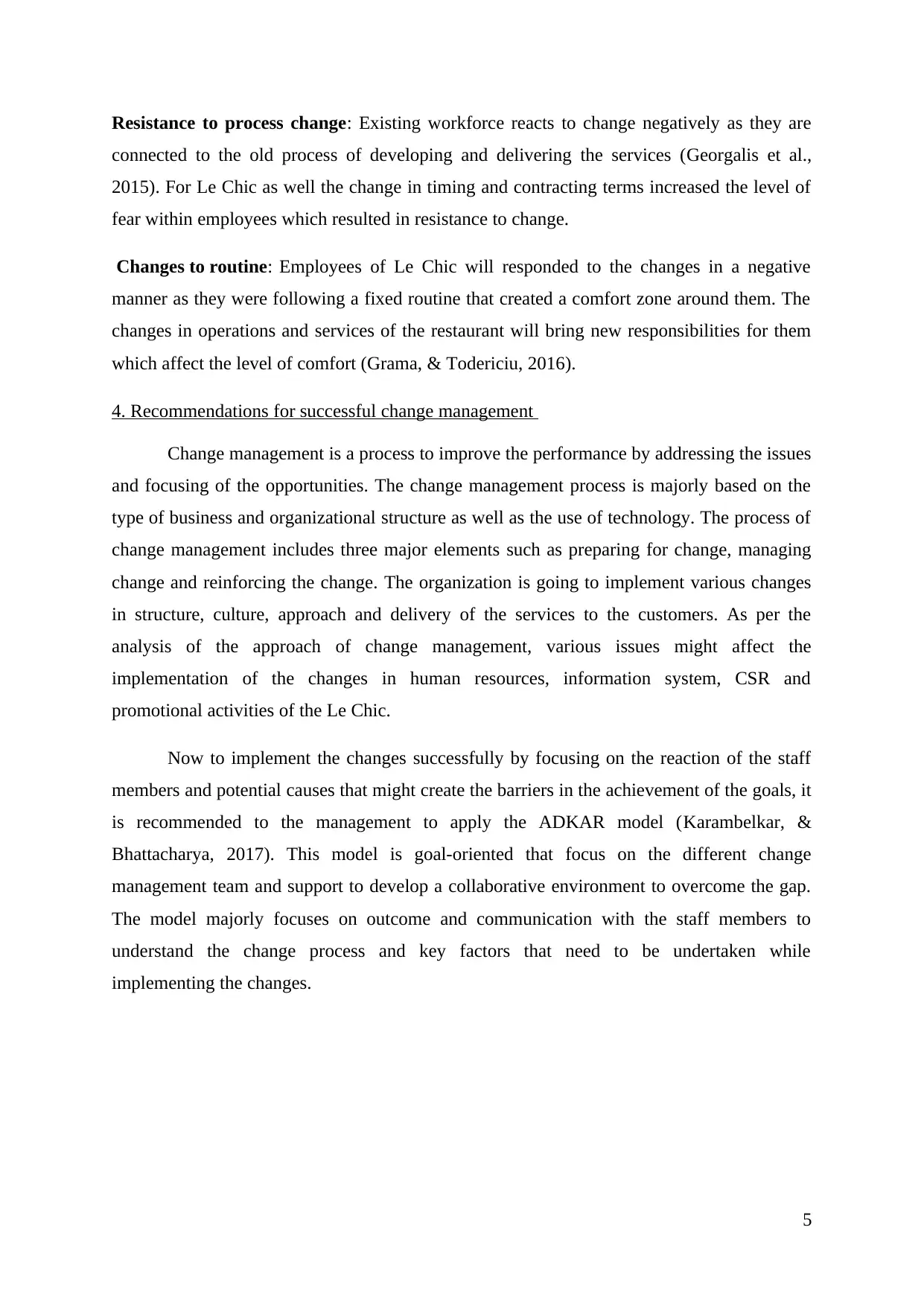
Resistance to process change: Existing workforce reacts to change negatively as they are
connected to the old process of developing and delivering the services (Georgalis et al.,
2015). For Le Chic as well the change in timing and contracting terms increased the level of
fear within employees which resulted in resistance to change.
Changes to routine: Employees of Le Chic will responded to the changes in a negative
manner as they were following a fixed routine that created a comfort zone around them. The
changes in operations and services of the restaurant will bring new responsibilities for them
which affect the level of comfort (Grama, & Todericiu, 2016).
4. Recommendations for successful change management
Change management is a process to improve the performance by addressing the issues
and focusing of the opportunities. The change management process is majorly based on the
type of business and organizational structure as well as the use of technology. The process of
change management includes three major elements such as preparing for change, managing
change and reinforcing the change. The organization is going to implement various changes
in structure, culture, approach and delivery of the services to the customers. As per the
analysis of the approach of change management, various issues might affect the
implementation of the changes in human resources, information system, CSR and
promotional activities of the Le Chic.
Now to implement the changes successfully by focusing on the reaction of the staff
members and potential causes that might create the barriers in the achievement of the goals, it
is recommended to the management to apply the ADKAR model (Karambelkar, &
Bhattacharya, 2017). This model is goal-oriented that focus on the different change
management team and support to develop a collaborative environment to overcome the gap.
The model majorly focuses on outcome and communication with the staff members to
understand the change process and key factors that need to be undertaken while
implementing the changes.
5
connected to the old process of developing and delivering the services (Georgalis et al.,
2015). For Le Chic as well the change in timing and contracting terms increased the level of
fear within employees which resulted in resistance to change.
Changes to routine: Employees of Le Chic will responded to the changes in a negative
manner as they were following a fixed routine that created a comfort zone around them. The
changes in operations and services of the restaurant will bring new responsibilities for them
which affect the level of comfort (Grama, & Todericiu, 2016).
4. Recommendations for successful change management
Change management is a process to improve the performance by addressing the issues
and focusing of the opportunities. The change management process is majorly based on the
type of business and organizational structure as well as the use of technology. The process of
change management includes three major elements such as preparing for change, managing
change and reinforcing the change. The organization is going to implement various changes
in structure, culture, approach and delivery of the services to the customers. As per the
analysis of the approach of change management, various issues might affect the
implementation of the changes in human resources, information system, CSR and
promotional activities of the Le Chic.
Now to implement the changes successfully by focusing on the reaction of the staff
members and potential causes that might create the barriers in the achievement of the goals, it
is recommended to the management to apply the ADKAR model (Karambelkar, &
Bhattacharya, 2017). This model is goal-oriented that focus on the different change
management team and support to develop a collaborative environment to overcome the gap.
The model majorly focuses on outcome and communication with the staff members to
understand the change process and key factors that need to be undertaken while
implementing the changes.
5
⊘ This is a preview!⊘
Do you want full access?
Subscribe today to unlock all pages.

Trusted by 1+ million students worldwide
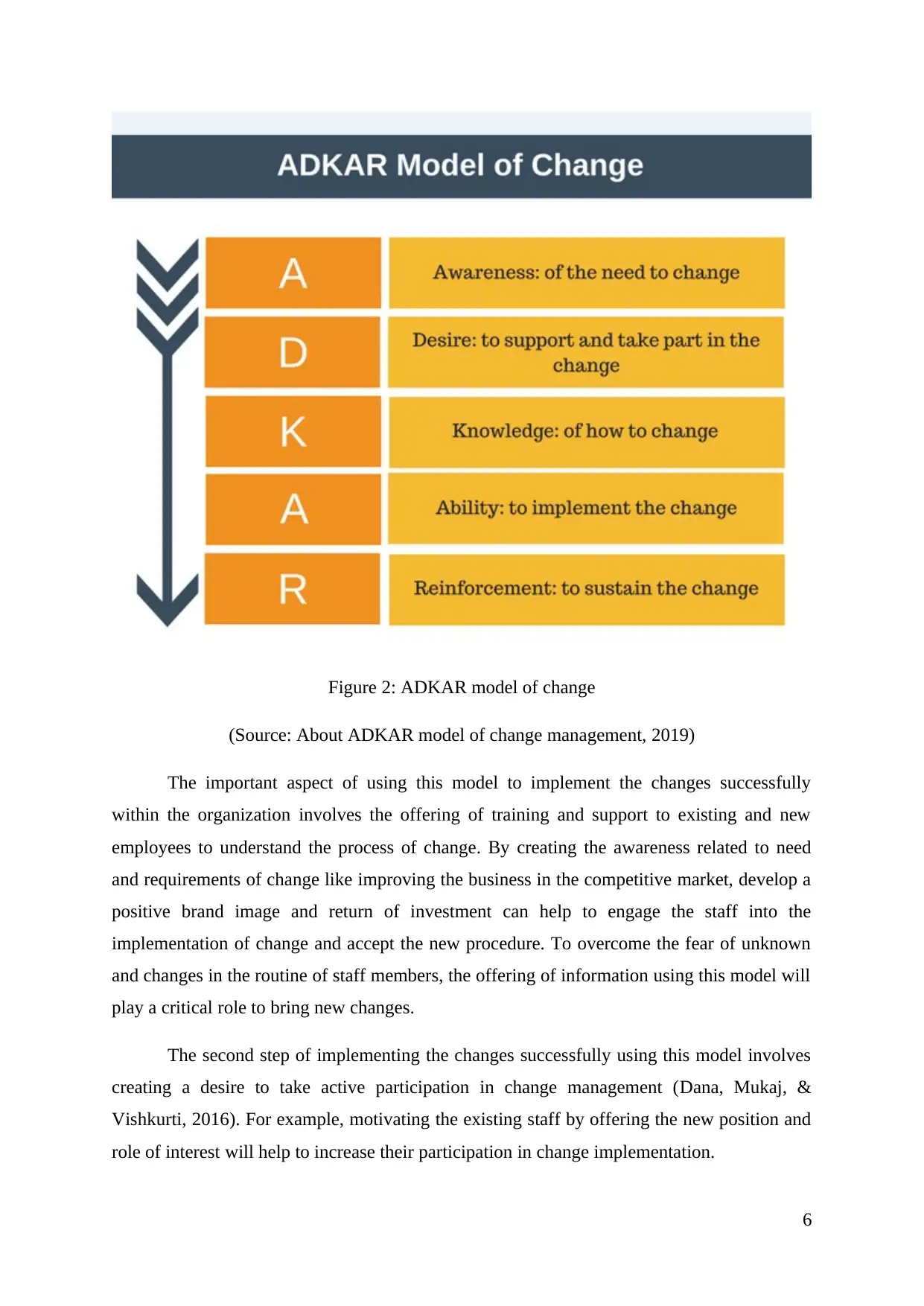
Figure 2: ADKAR model of change
(Source: About ADKAR model of change management, 2019)
The important aspect of using this model to implement the changes successfully
within the organization involves the offering of training and support to existing and new
employees to understand the process of change. By creating the awareness related to need
and requirements of change like improving the business in the competitive market, develop a
positive brand image and return of investment can help to engage the staff into the
implementation of change and accept the new procedure. To overcome the fear of unknown
and changes in the routine of staff members, the offering of information using this model will
play a critical role to bring new changes.
The second step of implementing the changes successfully using this model involves
creating a desire to take active participation in change management (Dana, Mukaj, &
Vishkurti, 2016). For example, motivating the existing staff by offering the new position and
role of interest will help to increase their participation in change implementation.
6
(Source: About ADKAR model of change management, 2019)
The important aspect of using this model to implement the changes successfully
within the organization involves the offering of training and support to existing and new
employees to understand the process of change. By creating the awareness related to need
and requirements of change like improving the business in the competitive market, develop a
positive brand image and return of investment can help to engage the staff into the
implementation of change and accept the new procedure. To overcome the fear of unknown
and changes in the routine of staff members, the offering of information using this model will
play a critical role to bring new changes.
The second step of implementing the changes successfully using this model involves
creating a desire to take active participation in change management (Dana, Mukaj, &
Vishkurti, 2016). For example, motivating the existing staff by offering the new position and
role of interest will help to increase their participation in change implementation.
6
Paraphrase This Document
Need a fresh take? Get an instant paraphrase of this document with our AI Paraphraser
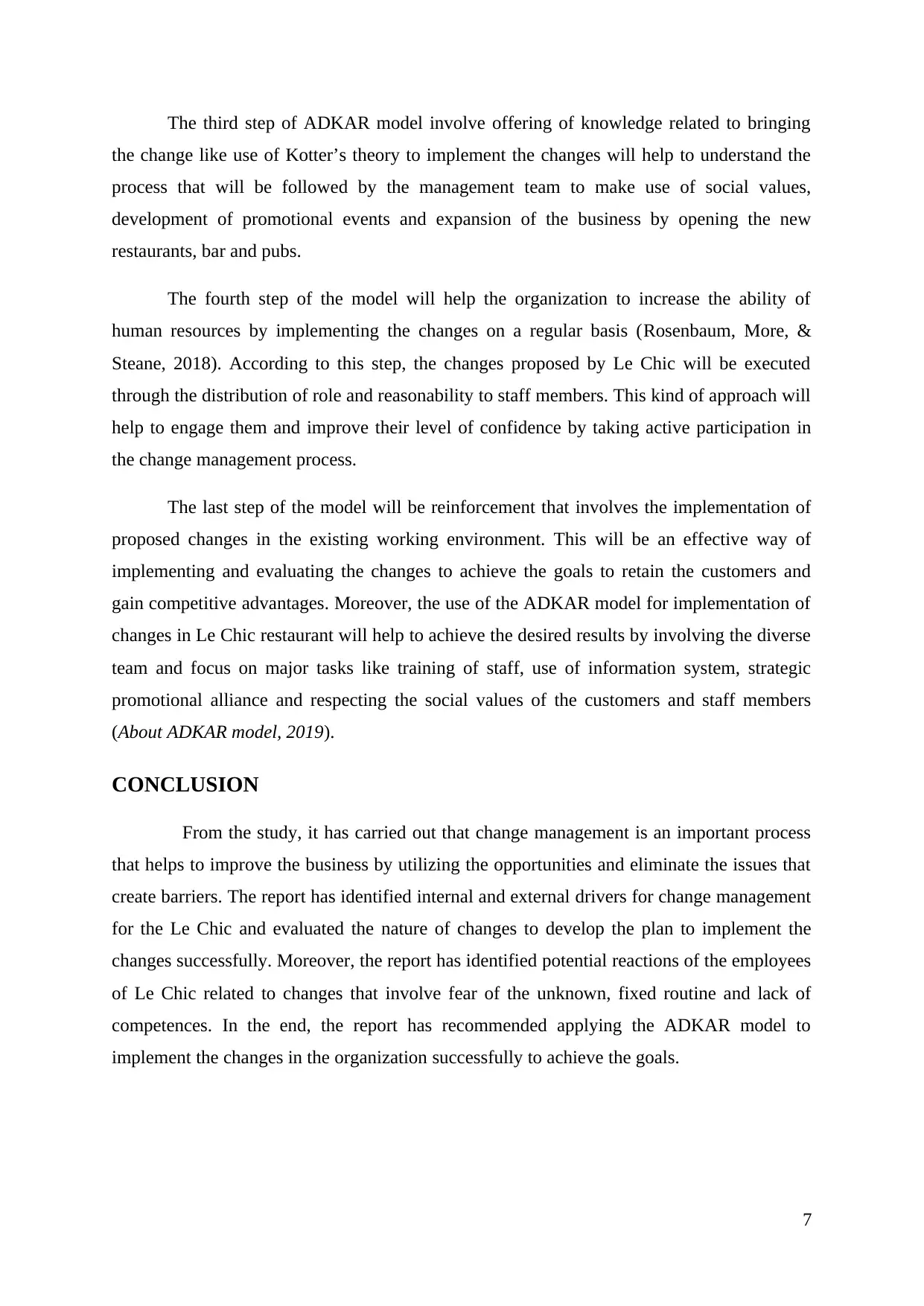
The third step of ADKAR model involve offering of knowledge related to bringing
the change like use of Kotter’s theory to implement the changes will help to understand the
process that will be followed by the management team to make use of social values,
development of promotional events and expansion of the business by opening the new
restaurants, bar and pubs.
The fourth step of the model will help the organization to increase the ability of
human resources by implementing the changes on a regular basis (Rosenbaum, More, &
Steane, 2018). According to this step, the changes proposed by Le Chic will be executed
through the distribution of role and reasonability to staff members. This kind of approach will
help to engage them and improve their level of confidence by taking active participation in
the change management process.
The last step of the model will be reinforcement that involves the implementation of
proposed changes in the existing working environment. This will be an effective way of
implementing and evaluating the changes to achieve the goals to retain the customers and
gain competitive advantages. Moreover, the use of the ADKAR model for implementation of
changes in Le Chic restaurant will help to achieve the desired results by involving the diverse
team and focus on major tasks like training of staff, use of information system, strategic
promotional alliance and respecting the social values of the customers and staff members
(About ADKAR model, 2019).
CONCLUSION
From the study, it has carried out that change management is an important process
that helps to improve the business by utilizing the opportunities and eliminate the issues that
create barriers. The report has identified internal and external drivers for change management
for the Le Chic and evaluated the nature of changes to develop the plan to implement the
changes successfully. Moreover, the report has identified potential reactions of the employees
of Le Chic related to changes that involve fear of the unknown, fixed routine and lack of
competences. In the end, the report has recommended applying the ADKAR model to
implement the changes in the organization successfully to achieve the goals.
7
the change like use of Kotter’s theory to implement the changes will help to understand the
process that will be followed by the management team to make use of social values,
development of promotional events and expansion of the business by opening the new
restaurants, bar and pubs.
The fourth step of the model will help the organization to increase the ability of
human resources by implementing the changes on a regular basis (Rosenbaum, More, &
Steane, 2018). According to this step, the changes proposed by Le Chic will be executed
through the distribution of role and reasonability to staff members. This kind of approach will
help to engage them and improve their level of confidence by taking active participation in
the change management process.
The last step of the model will be reinforcement that involves the implementation of
proposed changes in the existing working environment. This will be an effective way of
implementing and evaluating the changes to achieve the goals to retain the customers and
gain competitive advantages. Moreover, the use of the ADKAR model for implementation of
changes in Le Chic restaurant will help to achieve the desired results by involving the diverse
team and focus on major tasks like training of staff, use of information system, strategic
promotional alliance and respecting the social values of the customers and staff members
(About ADKAR model, 2019).
CONCLUSION
From the study, it has carried out that change management is an important process
that helps to improve the business by utilizing the opportunities and eliminate the issues that
create barriers. The report has identified internal and external drivers for change management
for the Le Chic and evaluated the nature of changes to develop the plan to implement the
changes successfully. Moreover, the report has identified potential reactions of the employees
of Le Chic related to changes that involve fear of the unknown, fixed routine and lack of
competences. In the end, the report has recommended applying the ADKAR model to
implement the changes in the organization successfully to achieve the goals.
7
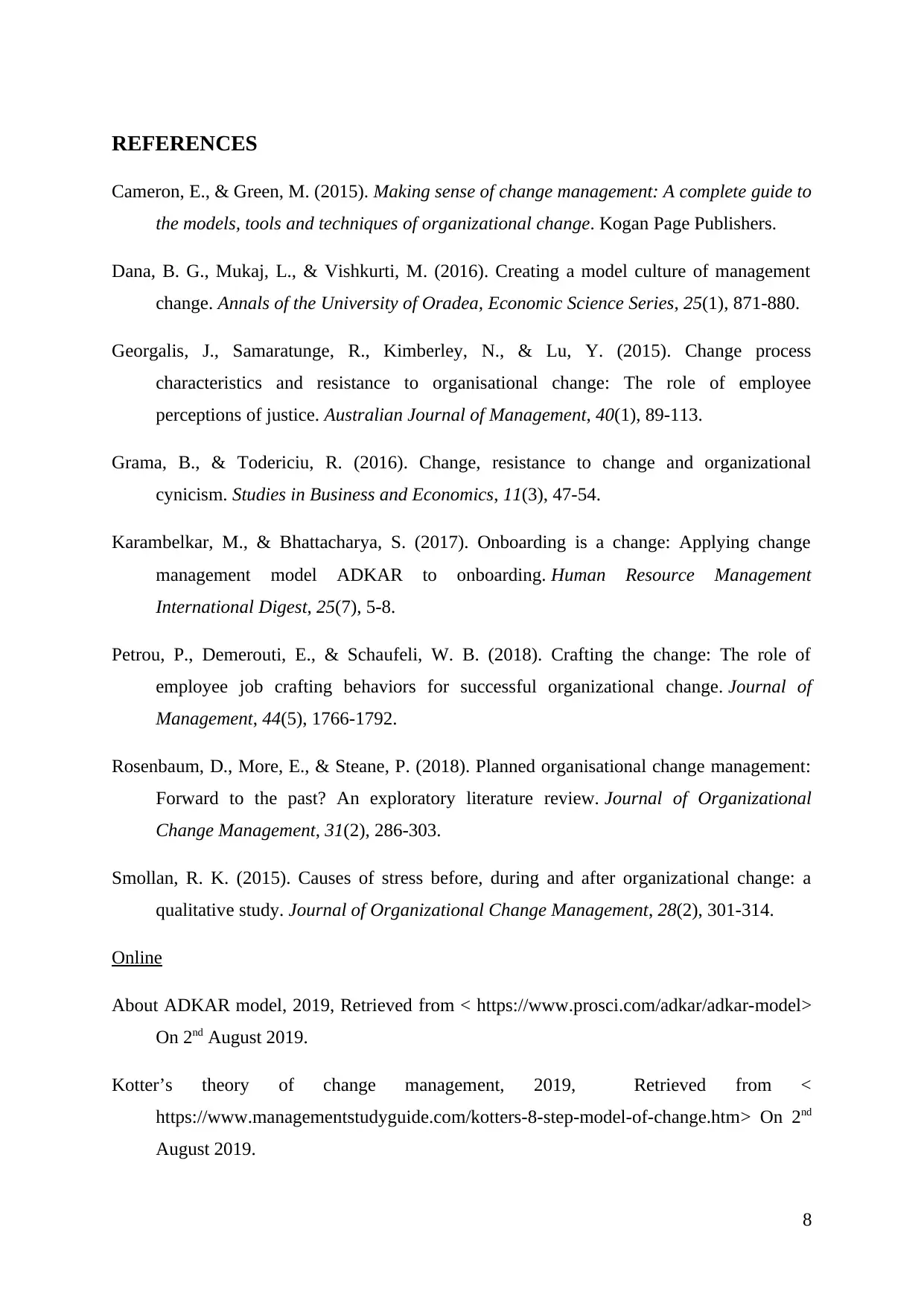
REFERENCES
Cameron, E., & Green, M. (2015). Making sense of change management: A complete guide to
the models, tools and techniques of organizational change. Kogan Page Publishers.
Dana, B. G., Mukaj, L., & Vishkurti, M. (2016). Creating a model culture of management
change. Annals of the University of Oradea, Economic Science Series, 25(1), 871-880.
Georgalis, J., Samaratunge, R., Kimberley, N., & Lu, Y. (2015). Change process
characteristics and resistance to organisational change: The role of employee
perceptions of justice. Australian Journal of Management, 40(1), 89-113.
Grama, B., & Todericiu, R. (2016). Change, resistance to change and organizational
cynicism. Studies in Business and Economics, 11(3), 47-54.
Karambelkar, M., & Bhattacharya, S. (2017). Onboarding is a change: Applying change
management model ADKAR to onboarding. Human Resource Management
International Digest, 25(7), 5-8.
Petrou, P., Demerouti, E., & Schaufeli, W. B. (2018). Crafting the change: The role of
employee job crafting behaviors for successful organizational change. Journal of
Management, 44(5), 1766-1792.
Rosenbaum, D., More, E., & Steane, P. (2018). Planned organisational change management:
Forward to the past? An exploratory literature review. Journal of Organizational
Change Management, 31(2), 286-303.
Smollan, R. K. (2015). Causes of stress before, during and after organizational change: a
qualitative study. Journal of Organizational Change Management, 28(2), 301-314.
Online
About ADKAR model, 2019, Retrieved from < https://www.prosci.com/adkar/adkar-model>
On 2nd August 2019.
Kotter’s theory of change management, 2019, Retrieved from <
https://www.managementstudyguide.com/kotters-8-step-model-of-change.htm> On 2nd
August 2019.
8
Cameron, E., & Green, M. (2015). Making sense of change management: A complete guide to
the models, tools and techniques of organizational change. Kogan Page Publishers.
Dana, B. G., Mukaj, L., & Vishkurti, M. (2016). Creating a model culture of management
change. Annals of the University of Oradea, Economic Science Series, 25(1), 871-880.
Georgalis, J., Samaratunge, R., Kimberley, N., & Lu, Y. (2015). Change process
characteristics and resistance to organisational change: The role of employee
perceptions of justice. Australian Journal of Management, 40(1), 89-113.
Grama, B., & Todericiu, R. (2016). Change, resistance to change and organizational
cynicism. Studies in Business and Economics, 11(3), 47-54.
Karambelkar, M., & Bhattacharya, S. (2017). Onboarding is a change: Applying change
management model ADKAR to onboarding. Human Resource Management
International Digest, 25(7), 5-8.
Petrou, P., Demerouti, E., & Schaufeli, W. B. (2018). Crafting the change: The role of
employee job crafting behaviors for successful organizational change. Journal of
Management, 44(5), 1766-1792.
Rosenbaum, D., More, E., & Steane, P. (2018). Planned organisational change management:
Forward to the past? An exploratory literature review. Journal of Organizational
Change Management, 31(2), 286-303.
Smollan, R. K. (2015). Causes of stress before, during and after organizational change: a
qualitative study. Journal of Organizational Change Management, 28(2), 301-314.
Online
About ADKAR model, 2019, Retrieved from < https://www.prosci.com/adkar/adkar-model>
On 2nd August 2019.
Kotter’s theory of change management, 2019, Retrieved from <
https://www.managementstudyguide.com/kotters-8-step-model-of-change.htm> On 2nd
August 2019.
8
⊘ This is a preview!⊘
Do you want full access?
Subscribe today to unlock all pages.

Trusted by 1+ million students worldwide
1 out of 12
Related Documents
Your All-in-One AI-Powered Toolkit for Academic Success.
+13062052269
info@desklib.com
Available 24*7 on WhatsApp / Email
![[object Object]](/_next/static/media/star-bottom.7253800d.svg)
Unlock your academic potential
Copyright © 2020–2025 A2Z Services. All Rights Reserved. Developed and managed by ZUCOL.





